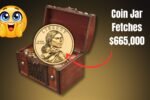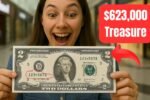The 1976 Bicentennial Quarter is more than a regular coin. It celebrates 200 years of American freedom. Made for the U.S. bicentennial, this special quarter has a unique design. While most are only worth 25 cents, a few rare ones have sold for huge amounts. One even sold for $500,000.
Many people keep these quarters for fun. But serious collectors look for the rare versions. These rare coins can be proof coins, have mint errors, or be in perfect condition.
A Coin Made for a Special Celebration
In 1976, the U.S. released special coins to honor 200 years of independence. These coins include a quarter, half-dollar, and dollar. The Bicentennial Quarter was designed by Jack L. Ahr.
The back of the quarter shows a Colonial drummer with 13 stars and a flame. This shows the spirit of the American Revolution. The front of the coin has two dates: “1776–1976.” This makes it different from other quarters.
What Makes Some Quarters So Valuable?
Most 1976 quarters are common. But a few rare ones are worth a lot. Here’s what makes them special:
Rarity
Billions of these quarters were made. But some versions are rare. One rare type is the 1976-S Proof Quarter. It was made in smaller numbers just for collectors.
These rare coins are hard to find, so their value goes up.
Condition
Collectors want coins in perfect condition. These coins are graded. A coin with a grade of “MS-70” or “PF-70” is in perfect shape.
If your coin has no scratches or marks, it can be worth thousands. Even small damage lowers the value.
Minting Errors
Sometimes mistakes happen when coins are made. These errors make the coins rare. Mistakes can include die cracks, double prints, or wrong shapes.
Coins with big errors are worth more than coins with small ones.
The 1976-S Proof Quarter: A Special Collector’s Item
This coin was made at the San Francisco Mint. It was made just for collectors. It has a shiny, mirror-like look.
Value Table:
| Type | Value Range |
| Standard Proof Coin | $5 – $50 |
| Perfect Condition (PF-70) | Over $1,000 |
How to Spot It:
- Look for an “S” under Washington’s head.
- The coin should be shiny and detailed.
Error Coins: Worth a Closer Look
Some coins have minting errors. These mistakes can make them valuable.
Error Coin Value Table:
| Error Type | Value Range |
| Minor Errors | $100 – $500 |
| Major Errors | $1,000 or more |
What to Look For:
Use a magnifying glass. Look for odd lines, double prints, or shapes that don’t look normal.
How to Know If You Have a Rare Bicentennial Quarter
Think you have a valuable coin? Here’s how to check:
Mint Mark
- “S” means it’s a proof coin from San Francisco.
- No mark or “D” means it’s from Philadelphia or Denver.
Surface
- Proof coins shine like mirrors.
- Regular coins look duller.
Errors
- Check for cracks, misprints, or double images.
Condition
- No scratches or marks mean higher value.
Silver Content
Some 1976-S proof quarters have 40% silver. They feel heavier than others.
If you’re not sure, get your coin graded by PCGS or NGC.
Why People Love Bicentennial Quarters
These quarters are more than money. They are a part of American history.
- History – They mark 200 years of U.S. freedom.
- Design – The drummer boy and double date are eye-catching.
- Value – Rare coins can bring in thousands.
How to Find a Valuable Bicentennial Quarter
You might find a rare quarter in your pocket. Here’s how to start looking:
- Check Older Coin Rolls – Look for 1975–1976 quarters.
- Look for Proof Coins – Sometimes these end up in regular use.
- Search for Errors – Use a magnifying glass to check the design.
- Watch Auctions – Keep up with how much these coins are selling for.
FAQs
What makes a 1976 quarter rare?
Proof coins, errors, or perfect condition.
What does the “S” mean on the coin?
It means it was made in San Francisco.
How do I check if it’s silver?
Silver coins are heavier and shinier.
Can I find rare coins in change?
Yes, check carefully.
Are all 1976 quarters valuable?
No, only special types are.


